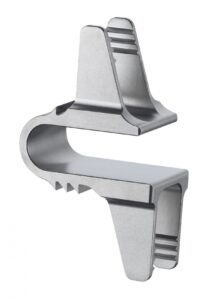COFLEX

Lumbar stenosis refers to a condition that develops in the spinal canal of the lower back when the canal narrows, putting pressure on the spinal cord. This pressure can lead to numbness, weakness, and tingling sensation in the back, legs and feet.
Although lumbar stenosis can put an individual in a debilitating state, surgeons consider this condition treatable. For people who suffer from moderate to severe lumbar stenosis, surgery can prove a great treatment option when nonsurgical methods have yield negative results.
Coflex surgery refers to one such option that can not only help alleviate pain, but also maintain full range of motion in the spine, unlike traditional surgeries that may require fusion.
What’s a Coflex Device?
Coflex surgery refers to a neurological procedure that implants a titanium alloy device, known as the Coflex Interlaminar Stabilization device, in the back of the spine to relieve pain or numbness in the back, legs or buttocks from spinal stenosis.
The coflex device itself refers to a U-shaped, strong, and flexible piece of titanium allow. Surgeons insert this device between two adjacent lower back bones immediately after performing surgical decompression of the affected vertebrae.
The flexibility and strength of the device allows it to support the spine without the need for spinal fusion, maintaining the spine’s full range of motion. This remarkable device can come in five different sizes in order to meet the anatomical needs of the patient.
How’s Coflex Surgery performed?
- The Coflex Procedure
This procedure includes a non-fusion, minimally-invasive alternative to laminectomy with or without spinal fusion. An anesthesiologist administers preparation anesthesia and positions the patient. The surgeon then makes a small incision in the lower back.
- Accessing the Spine
The surgeon creates this opening through the ligaments at the rear of the spine. The surgeon can now access the spinous processes, the bony protrusions on the back of the spine, of the problem vertebrae.
- Preparing the Implant Site
Some of the bony overgrowth of the spinous process may require removal for the implant to fit properly. A small portion of one or more lamina may also need resurfacing.
- Implanting the Coflex
Using fluoroscopic guidance, the surgeon inserts the Coflex implant through the incision and places it between the spinous processes.
- End of Procedure and Aftercare
In many patients, the patient may return home the same day or after an overnight stay. The surgeon will determine the length of stay in the outpatient center and will guide the post-operative recovery.
Who’s a Candidate For Coflex Surgery?
Most surgeons favor patients within 40 years of age or older, as the patient must have reached full skeletal maturity. Other criteria surgeons look for include:
- No pregnancy
- No prior lumbar fusions
- No lumbar disc herniation needing concurrent surgery
- Moderate to severe lumbar stenosis
Risks Associated with Coflex Surgery
As with any open surgery, the Coflex surgery does carry some inherent risks. Fortunately, the risks involved with Coflex surgery prove typically rare. The largest risk patients considering the Coflex surgery face includes the chance of continued pain. However, some other risks to consider before deciding on undergoing this surgery include:
- Wound healing complications
- Infection
- Drainage
- Numbness or tingling in the arms or legs
- Spinous process fractures
If the device fails to bring pain relief, one may need to undergo further surgery to have it removed. This proves rare, but surgeons can perform it if necessary.
Results after Surgery
One of the benefits when considering Coflex surgery includes a shorter stay in the outpatient center and recovery time. Most patients that underwent Coflex surgery leave within 24-48 hours after surgery.
Following surgery, the doctor may prescribe a physical therapy plan to help aid recovery. The patient must ensure to follow the therapist’s and doctor’s instructions to avoid any potential complications. Some patients may also require pain medication to help alleviate any pain associated with the surgery. Fortunately, a large number of patients experience significant pain relief within 6 weeks of undergoing surgery.
One should also keep in mind that getting the Coflex surgery involves having a metal implant in the body. This may affect X-rays, MRI scans, and metal detectors. Talk to the surgeon about getting a patient ID card in order to avoid any issues in the future.
